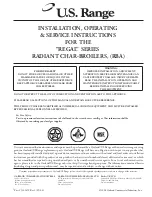
PAGE 12
SEQ
SEQ
SEQ
SEQ
SEQUENCE OF OPERA
UENCE OF OPERA
UENCE OF OPERA
UENCE OF OPERA
UENCE OF OPERATION
TION
TION
TION
TION
On a call for heat:
1.) The thermostat will actuate, completing the circuit between terminals T and T.
2.) The R8222C relay coil will energize thus pulling in the relay contacts.
3.) The circulator starts and power is switched to the limit. If limit circuit is closed the venter
motor and TR-2 transformer are energized.
4.) The venter motor starts and develops static pressure.
5.) When the static pressure is reached the pressure switch pulls in completing the circuit
between TR-2 and the SV9501H gas valve system.
6.) The SV9501H opens the pilot valve and ignites pilot. After pilot is proven the main
burner will ignite.
7.) In the event the boiler water temperature exceeds the high limit setting the power will
be interrupted to the venter motor, and TR-2, thus interrupting power to the ignition
system. Power will remain off until the water temperature drops below the high limit
setting. The circulator will continue to operate under this condition until the thermostat
is satisfied.
8.) Should the air flow (static pressure) be interrupted (ie. blocked flue), the pressure
switch will sense a drop in pressure, opening the circuit between the ignition system
and TR-2. The venter motor will continue to operate until static pressure is reached or
thermostat is satisfied.
9.) In the event the flow of combustion products through the boiler flueways becomes
reduced or blocked, the Q34505 pilot will lose flame rectification and shut off the main
burners. The boiler will try for ignition but will not light. If this condition occurs, turn off
the main power and do not put the unit into operation.
10.) When the thermostat is satisfied power is interrupted to the relay coil and the relay
drops out cutting power to the circulator, venter motor, and TR-2.














































